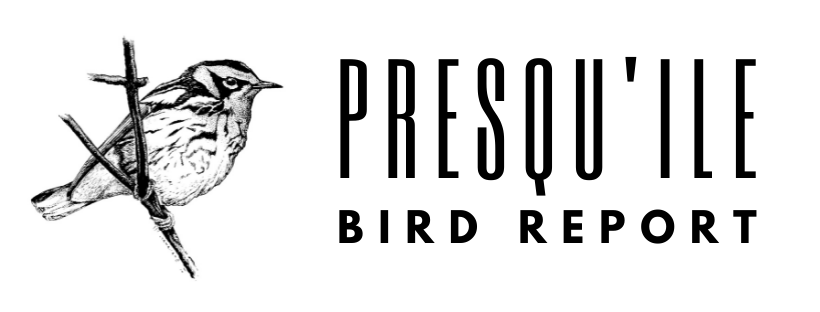
At Presqu'ile Provincial Park, both birders and birds seem to have been impatient to get moving. Finally last night some of the latter decided it was time to move in. Before that, some of the more interesting sightings were late lingering winter birds, rather than early spring arrivals.
CANADA GEESE have begun what appears to be a molt migration, as flocks are heading north overhead. MUTE SWANS have apparently chased almost all other waterfowl out of the marsh and into other nearby waters. It is surely time to take seriously suggestions that this invasive species be brought under control. NORTHERN SHOVELERS (4 today) and NORTHERN PINTAILS (3 on Monday) were in Popham Bay. A REDHEAD was also there today. The most plentiful ducks these days are LONG-TAILED DUCKS, many of which have taken on their alternate (breeding) plumage as they await the time when their arctic breeding grounds open up. A female HOODED MERGANSER, the first since mid-April, was in Popham Bay today. Three RED-THROATED LOONS were there on Monday, and two today. A lone RED-NECKED GREBE and several HORNED GREBES were off the day use area this morning.
GREAT EGRETS are being seen daily. After being evicted from Sebastopol Island by DOUBLE-CRESTED CORMORANTS for the past few years, BLACK-CROWNED NIGHT-HERONS appear, at least for now, to be reclaiming that former nesting site. SHARP-SHINNED and COOPER'S HAWKS have both been seen this week. As this report was being completed, a call came in that a YELLOW RAIL was ticking at the marsh boardwalk, the first in several years. Low water levels in the marsh may be providing better habitat for that species than in recent years. Another highlight was a SANDHILL CRANE that flew over calling, a species that appears at Presqu'ile only once or twice a year as a rule. The main shorebird migration is still a few weeks away, but the vanguard, consisting of two SEMIPALMATED PLOVERS, one or two SPOTTED SANDPIPERS, and two GREATER YELLOWLEGS, have been on the beach. Both ICELAND and GLAUCOUS GULLS were seen at Owen Point on Saturday, and a LESSER BLACK-BACKED GULL was there on Tuesday. The first COMMON TERNS arrived today. A late SNOWY OWL was seen on Sunday. At 1:30 this afternoon, a BARRED OWL was calling behind 83 Bayshore Road in Newcastle woods.
Optimistic birders have put out their hummingbird feeders, recognizing that this is about the normal arrival date for RUBY-THROATED HUMMINGBIRDS. A RED-BELLIED WOODPECKER was seen yesterday. Two COMMON RAVENS were spotted twice this week, including at Owen Point this morning. Among the new arrivals today was a large number of HERMIT THRUSHES, one observer noting 15. Within the last two days, the number of warbler species found in the Park this spring has tripled, new ones being NORTHERN WATERTHRUSH, BLACK-AND-WHITE WARBLER, NASHVILLE WARBLER, and BLACK-THROATED GREEN WARBLER. A few EASTERN TOWHEES, a FOX SPARROW, and nine RUSTY BLACKBIRDS are further signs that species expected in April did indeed show up. PINE SISKINS have been present all week at 83 Bayshore Road, and a female EVENING GROSBEAK was there on Sunday. The male HOUSE SPARROW at 186 Bayshore Road has unfortunately been joined by a female for the past two days.
To reach Presqu'ile Provincial Park, follow the signs from Brighton.
Locations within the Park are shown on a map at the back of a tabloid that is available at the Park gate. Access to the offshore islands is restricted from March 10 onward to prevent disturbance to the colonial nesting birds there.
Birders are encouraged to record their observations on the bird sightings board provided near the campground office by The Friends of Presqu'ile Park and to fill out a rare bird report for species not listed there.
Questions and comments about bird sightings at Presqu'ile may be directed to: FHELLEINER@TRENTU.CA.


